This the very reason I've decided to use min phase version of the microphone calibration. At least mic phase effects will not show up in excess phase graphs.this might make the linear phase ideal in the bass ilusional
-
WANTED: Happy members who like to discuss audio and other topics related to our interest. Desire to learn and share knowledge of science required. There are many reviews of audio hardware and expert members to help answer your questions. Click here to have your audio equipment measured for free!
You are using an out of date browser. It may not display this or other websites correctly.
You should upgrade or use an alternative browser.
You should upgrade or use an alternative browser.
Compensating for mains and sub delay
- Thread starter ErLan
- Start date
The filter you produced here should have caused a light pre-echo effect according to my theories but it doesn't. I literally convolved it and played an echo crazy track and there was none of it.Maximum Q=4 for an APF is probably is still "acceptable" -- any more than that I wouldn't use...
The corrected response hits -19dB at -12ms and almost all my filters pre-ring if anything beyond -10ms is above -25dB. Dirac live claims they don't go over -35dB below -5ms!
Looks like I'll need to find some other theory to spot pre-ringing
ernestcarl
Major Contributor
- Thread Starter
- #104
Hello,
Getting back to you with some insights (& sample of measurements!)
STEP1:
Post IIR tuning, I performed multiple measurements in the LP area, which allowed my to get an average SubLt+SubRt
Following @ernestcarl advice I average SubLt+SubRt and applied the inverse phase method (@dasdoing , @ernestcarl ) which was straightforward using REW 5.20.13-14, and the snapshots in this thread; the resulted FIR was applied using EQAP.
Last, Remeasured SubLt, SubRt (separately).
Simulation was accurate! the Sub delay was reduced to create a nearly perfect spectrogram.
When listening to selected tracks, pre-ringing was not noticed, sound was tight, and the 3D image was laser sharp, and seems like detached from the speakers. Thanks for that friends!
(see part 1)
STEP2:
Nevertheless, As can be seen by the measurements there is still a delayed sounds in the100-250Hz region,
Curious to understand that, I run few preliminary checks, which clearly pointed out that it is not related to the sub (changing sub crossover & Sub was bypassed (part 3) but most likely a cluster of modal peaks caused by non-ideal, untreated room :/ (== life).
Changing the speakers position obviously influence (part 2) but not to a degree that notably reduce it, I am thinking now to run measurements on alternative LP to get to a possible better sweet spot (maybe a room for another thread in the Room correction forum )
)
Last,
I also approached Wharfedale service to see whether they have some quantitative inputs on the possible delay caused by active amplification of the sub (where I suspect the main chunk of delay comes from) - no answer yet but submitted my question only 2d ago, so I guess they will get back to me in few days.
I guess this 'bulletin' may bring question which I am willing to answer. vast data can also be shared (currently working to arrange it to be more self explanatory).
Getting back to you with some insights (& sample of measurements!)
STEP1:
Post IIR tuning, I performed multiple measurements in the LP area, which allowed my to get an average SubLt+SubRt
Following @ernestcarl advice I average SubLt+SubRt and applied the inverse phase method (@dasdoing , @ernestcarl ) which was straightforward using REW 5.20.13-14, and the snapshots in this thread; the resulted FIR was applied using EQAP.
Last, Remeasured SubLt, SubRt (separately).
Simulation was accurate! the Sub delay was reduced to create a nearly perfect spectrogram.
When listening to selected tracks, pre-ringing was not noticed, sound was tight, and the 3D image was laser sharp, and seems like detached from the speakers. Thanks for that friends!
(see part 1)
STEP2:
Nevertheless, As can be seen by the measurements there is still a delayed sounds in the100-250Hz region,
Curious to understand that, I run few preliminary checks, which clearly pointed out that it is not related to the sub (changing sub crossover & Sub was bypassed (part 3) but most likely a cluster of modal peaks caused by non-ideal, untreated room :/ (== life).
Changing the speakers position obviously influence (part 2) but not to a degree that notably reduce it, I am thinking now to run measurements on alternative LP to get to a possible better sweet spot (maybe a room for another thread in the Room correction forum
Last,
I also approached Wharfedale service to see whether they have some quantitative inputs on the possible delay caused by active amplification of the sub (where I suspect the main chunk of delay comes from) - no answer yet but submitted my question only 2d ago, so I guess they will get back to me in few days.
I guess this 'bulletin' may bring question which I am willing to answer. vast data can also be shared (currently working to arrange it to be more self explanatory).
Attachments
ernestcarl
Major Contributor
Hello,
Getting back to you with some insights (& sample of measurements!)
STEP1:
Post IIR tuning, I performed multiple measurements in the LP area, which allowed my to get an average SubLt+SubRt
Following @ernestcarl advice I average SubLt+SubRt and applied the inverse phase method (@dasdoing , @ernestcarl ) which was straightforward using REW 5.20.13-14, and the snapshots in this thread; the resulted FIR was applied using EQAP.
Last, Remeasured SubLt, SubRt (separately).
Simulation was accurate! the Sub delay was reduced to create a nearly perfect spectrogram.
When listening to selected tracks, pre-ringing was not noticed, sound was tight, and the 3D image was laser sharp, and seems like detached from the speakers. Thanks for that friends!
(see part 1)
STEP2:
Nevertheless, As can be seen by the measurements there is still a delayed sounds in the100-250Hz region,
Curious to understand that, I run few preliminary checks, which clearly pointed out that it is not related to the sub (changing sub crossover & Sub was bypassed (part 3) but most likely a cluster of modal peaks caused by non-ideal, untreated room :/ (== life).
Changing the speakers position obviously influence (part 2) but not to a degree that notably reduce it, I am thinking now to run measurements on alternative LP to get to a possible better sweet spot (maybe a room for another thread in the Room correction forum)
Last,
I also approached Wharfedale service to see whether they have some quantitative inputs on the possible delay caused by active amplification of the sub (where I suspect the main chunk of delay comes from) - no answer yet but submitted my question only 2d ago, so I guess they will get back to me in few days.
I guess this 'bulletin' may bring question which I am willing to answer. vast data can also be shared (currently working to arrange it to be more self explanatory).
I mostly averaged it to save time.
Seems REW cannot limit how much of a GD peak to pull down.
ernestcarl
Major Contributor
Nevertheless, As can be seen by the measurements there is still a delayed sounds in the100-250Hz region,
Acoustic treatment will help there
dasdoing
Major Contributor
sorry, wont analise the new stuff now,
but I would like to point out something about the first left channel he provided.
what is the worst thing in that IR? it is an anoying resonance at 379Hz.
see if you hear it. if not I can provide examples of before and after.
the thing is, i atenuated it 50q and 6dB it it was still not gone.
had to atenuate 12dB.
I see this as an disturbing example of how the standard procedures might not be enough. because I don't think any EQ correcting method could figure that out. or could it?
can you guys hear it?
but I would like to point out something about the first left channel he provided.
what is the worst thing in that IR? it is an anoying resonance at 379Hz.
see if you hear it. if not I can provide examples of before and after.
the thing is, i atenuated it 50q and 6dB it it was still not gone.
had to atenuate 12dB.
I see this as an disturbing example of how the standard procedures might not be enough. because I don't think any EQ correcting method could figure that out. or could it?
can you guys hear it?
dasdoing
Major Contributor
untreated rooms are just crazy.
from what I understand, OP's latested mdat is averaged meassurements? and we still get this:

this is a 10dB range, resonanty af
I garantee you guys I can show you half of those in action if I look for the right songs.
in comparison my mains in my DIY treated room, and these are PA speakers, and it's a single measurement:

still not heaven in hell...I know.
but you see that crazy peak at 420-ish?
look what it did after room EQ: https://www.audiosciencereview.com/...ou-guys-hear-a-resonance-in-this-track.46213/
yea, it was emphasized after I (experimentily) room corrected it, but still....these are serious problems that will stick out depending on the material. every single one of these.
we can manually minimum phase EQ these down one by one, but this will probably create a FR full of holes.
for a single measurement though, and I am very aware of this, we can control all of these with phase manipulation,
so we just have to find a way to make it work more broadly
from what I understand, OP's latested mdat is averaged meassurements? and we still get this:
this is a 10dB range, resonanty af
I garantee you guys I can show you half of those in action if I look for the right songs.
in comparison my mains in my DIY treated room, and these are PA speakers, and it's a single measurement:
still not heaven in hell...I know.
but you see that crazy peak at 420-ish?
look what it did after room EQ: https://www.audiosciencereview.com/...ou-guys-hear-a-resonance-in-this-track.46213/
yea, it was emphasized after I (experimentily) room corrected it, but still....these are serious problems that will stick out depending on the material. every single one of these.
we can manually minimum phase EQ these down one by one, but this will probably create a FR full of holes.
for a single measurement though, and I am very aware of this, we can control all of these with phase manipulation,
so we just have to find a way to make it work more broadly
ernestcarl
Major Contributor
what is the worst thing in that IR? it is an anoying resonance at 379Hz.
see if you hear it. if not I can provide examples of before and after.
the thing is, i atenuated it 50q and 6dB it it was still not gone.
had to atenuate 12dB.
I see this as an disturbing example of how the standard procedures might not be enough. because I don't think any EQ correcting method could figure that out. or could it?
can you guys hear it?
Did not the think too much about all that other stuff as primary question was with the sub’s response. There’s so many variables why room measurements are so far from ideal — but, I think that’s the norm — better to isolate one by one the different possible sources and have another reference to compare.
I haven’t really tried convolving the OP’s IR so I can simulate hearing his speakers for myself. You have to know the details about the measurement procedure performed (including reliability and repeatability) and other setup minutiae.
dasdoing
Major Contributor
You have to know the details about the measurement procedure performed (including reliability and repeatability) and other setup minutiae.
I think we can agree that what we are doing here is more theoretical than practical. It might even be possible to correct a system from a distance, but we certainly need way more information and measurements
- Thread Starter
- #111
I am also in favor of the step-by-step approach (audiophile endless journeyDid not the think too much about all that other stuff as primary question was with the sub’s response. There’s so many variables why room measurements are so far from ideal — but, I think that’s the norm — better to isolate one by one the different possible sources and have another reference to compare.
I haven’t really tried convolving the OP’s IR so I can simulate hearing his speakers for myself. You have to know the details about the measurement procedure performed (including reliability and repeatability) and other setup minutiae.
Looking at my spectrogram, I thought next step should be the 100-350Hz resonance(?) That may smear the sound in that range. Neveetheless @dasdoing , it seems like you believe that that 400Hz resonance is more influential? (If so, why?)
Measurements-wise, there are planty also willing to generate if there may be a need.
I think we can agree that what we are doing here is more theoretical than practical.
Yes, I agree/feel so.
I myself always prefer/recommend, therefore, "to start with", rather primitive and straightforward "validated" "reproducible" "reliable" "practical" measurements and tuning for time alignment and transient optimization (XO Fq/filter slopes/delay, etc.) between sub-woofers and woofers like I shared in my above post #84.
Last edited:
ernestcarl
Major Contributor
I am also in favor of the step-by-step approach (audiophile endless journey)
As a first step, and for your own reference, find out how a "clean" (anechoic or very nearfield and/or filtered/gated and well away from boundaries) measurement of your speakers looks like compared to a sweep at the real MLP.
Rythmik F12 subwoofer manufacturer measurement vs in-room

*red trace taken only few cm (5? or something) from cone surface
Main studio monitors
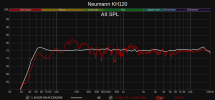
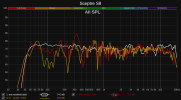
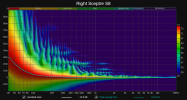
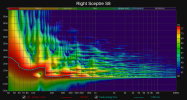
Some of your USB mic measurements also look "glitchy" (can happen in the beginning, middle or end of the sweep). XLR mics that share the same clock sync as the outputs don't normally suffer from this kind of issue.
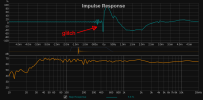
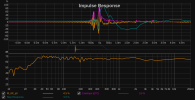
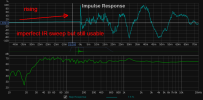
Last edited:
ernestcarl
Major Contributor
Neveetheless @dasdoing , it seems like you believe that that 400Hz resonance is more influential?
Actually, last graph example referred (+400 Hz time domain skew & resonance) was from his own personal speaker.
Last edited:
- Thread Starter
- #115
As a first step, and for your own reference, find out how a "clean" (anechoic or very nearfield and/or filtered/gated and well away from boundaries) measurement of your speakers looks like compared to a sweep at the real MLP.
Rythmik F12 subwoofer manufacturer measurement vs in-room

View attachment 301109
*red trace taken only few cm (5? or something) from cone surface
Main studio monitors
View attachment 301101 View attachment 301102 View attachment 301103 View attachment 301104
[ErLan] And - expecting a similar room influence on them - should I use them for some sort of normalization? Or are they more for a semi quantitative reference that demonstrates the topmost potential of the results I can get with that speaker?
Some of your USB mic measurements also look "glitchy" (can happen in the beginning, middle or end of the sweep). XLR mics that share the same clock sync as the outputs don't normally suffer from this kind of issue.
[ErLan] I guess it requires a dedicated audio interface?
- Thread Starter
- #116
(@ernestcarl From some reason my questions were integrated to your reply, you can see them by opening it, under [ErLan] prefix ... sorry, still learning )
I am also in favor of the step-by-step approach (audiophile endless journey)
I too agree.
Just for a typical example and reference, I actually did really step-by-step measurements of Fq-response at various "stages" of DSP-based multichannel multi-SP-driver multi-amplifier audio system as shared/summarized here on my project thread. This type of intensive step-by-step measurements give us deep insights for our further optimization and improvements. (After that, I have moved into time alignment and transient optimization as summarized in my above post #84.)
If you would be interested, you can find here and here the Hyperlink Index for my "step-by-step" multichannel audio project.
ernestcarl
Major Contributor
"should I use them for some sort of normalization? Or are they more for a semi quantitative reference that demonstrates the topmost potential of the results I can get with that speaker?"
Just gives you a good idea of what is very likely the real speaker's axial response vs in-room acoustics induced deviations.
Deeper analysis involves finding out what's the cause of measured deviations (e.g. SBIR/LBIR, diffraction, measurement position) and what's worth correcting with DSP and/or physical changes in the room (e.g. acoustic treatment, listener-speaker re-positioning).
I guess it requires a dedicated audio interface?
No need. Measure multiple times or check each result and simply discard the rest. Analogy would be that of your smart phone camera where you only pick/print out the "best" shot out of a dozen takes.
Just gives you a good idea of what is very likely the real speaker's axial response vs in-room acoustics induced deviations.
Deeper analysis involves finding out what's the cause of measured deviations (e.g. SBIR/LBIR, diffraction, measurement position) and what's worth correcting with DSP and/or physical changes in the room (e.g. acoustic treatment, listener-speaker re-positioning).
I guess it requires a dedicated audio interface?
No need. Measure multiple times or check each result and simply discard the rest. Analogy would be that of your smart phone camera where you only pick/print out the "best" shot out of a dozen takes.
dasdoing
Major Contributor
Looking at my spectrogram, I thought next step should be the 100-350Hz resonance(?) That may smear the sound in that range. Neveetheless @dasdoing , it seems like you believe that that 400Hz resonance is more influential? (If so, why?)
what I heard in the first left IR you posted is following:
here is the drum intro of Billie Jean convolved with the IR, and than it repeats but with a single notch filter engaged:
hopefully it becomes clear how much this filter cleans up the audio
use headphones https://drive.google.com/file/d/1-pHLLrkzCRQw2cOTPK3jfC_DzuuFy2-W/view?usp=sharing
now I don't know if this is really that dramatic in the real room.
that first MDAT was single measurement?
the second MDAT averaged?
I hear another high pitched resonance at another part in MJ's voice
dasdoing
Major Contributor
what I heard in the first left IR you posted is following:
here is the drum intro of Billie Jean convolved with the IR, and than it repeats but with a single notch filter engaged:
View attachment 301198
hopefully it becomes clear how much this filter cleans up the audio
use headphones https://drive.google.com/file/d/1-pHLLrkzCRQw2cOTPK3jfC_DzuuFy2-W/view?usp=sharing
now I don't know if this is really that dramatic in the real room.
that first MDAT was single measurement?
the second MDAT averaged?
I hear another high pitched resonance at another part in MJ's voice
I forgot,
I don't think this is coming from the speaker. it's probably a window? you could play a sine wave at around 376Hz and touch the surfaces until you find it.
